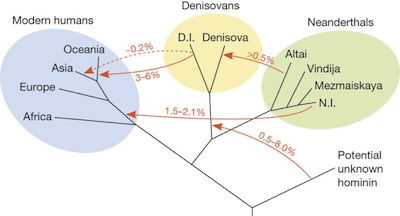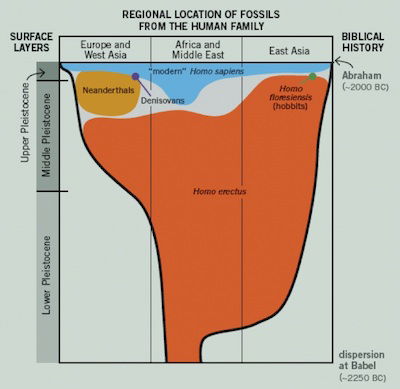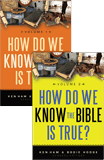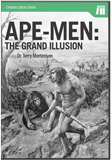
Neanderthal Toe Said to Suggest an Incestuous Culture
News to Know
Abstract
Neanderthal toe and Denisovan finger trace humanity’s genetic footprint near and far.
News Source
- ScienceDaily: “Neanderthal Genome Shows Early Human Interbreeding, Inbreeding”
Like the Denisovan genome recovered from a finger bone, a Neanderthal toe from the very same Siberian cave of wonders has yielded up secrets of humanity’s past. Not surprisingly, the ancestral web evident from the genomic analysis published in Nature is quite consistent with the story of our past found in the Bible’s book of Genesis.
Human Groups Isolated but Related
The high-quality complete genomic sequence obtained from the bone—a Neanderthal woman’s toe—confirms other genetic data suggesting that Neanderthals and Denisovans had mixed with each other and with early modern humans. The extent of the intermingling of people groups seems somewhat limited, however, as we would expect in the wake of humanity’s dispersion from the Tower of Babel.
“Admixture seems to be common among human groups,”1 says lead author Kay Prüfer. “Nevertheless,” Prüfer, Svante Pääbo, and their colleagues write, “Our analyses show that hominin2 groups met and had offspring on many occasions in the Late Pleistocene, but that the extent of gene flow between the groups was generally low.”3
Mystery Ancestor
The research team, based at the Max Planck Institute for Evolutionary Anthropology in Leipzig, Germany, also has found the genetic footprint of another group of humans in the woman’s toe. While they cannot be certain at this point, they suggest the unidentified ancestor could be Homo erectus, a variety of human known from fossils but from whom no DNA has been identified to date.
The identity of the mystery ancestor may not be known until DNA associated with a definitive Homo erectus fossil can be recovered. “Some unknown archaic DNA might have caught a ride through time by living on in Denisovans until we dug the individual up and sequenced it,” commented Prüfer. “It opens up the prospect to study the sequence of an archaic (human lineage) that might be out of reach for DNA sequencing.”4

DNA from this Neanderthal toe bone, found in Denisova, was completely sequenced. Its mitochondrial DNA was compared to Neanderthal samples from other sites. The toe’s owner appears to have been more closely related to an infant from Mezmaiskaya, 2,100 miles away. The Neanderthal toe’s DNA suggested the owner’s ancestors included Denisovans, early modern humans, and an unknown group of people. Image: K. Prüfer et al., “The complete genome sequence of a Neanderthal from the Altai Mountains,” Nature (2013), doi:10.1038/nature12886.

This diagram depicts four groups of early humans whose genetic footprints remain in a Neanderthal woman’s toe found in a Siberian Altai Mountain cave’s Ice Age sediment. The “potential unknown hominin” could be Homo erectus. The lines and numbers represent gene flow, whether direct or indirect, thought to have occurred between the groups and the resulting percentages evident in the genomes of various populations. Image: K. Prüfer et al., “The complete genome sequence of a Neanderthal from the Altai Mountains,” Nature (2013) doi:10.1038/nature12886.

This graph from “When Did Cavemen Live?” sorts out some of the various names assigned to varieties of humans and the geological layers in which they are found in light of biblical history. The earliest human remains are found in Ice Age deposits near Babel. By the middle of the Ice Age, however, human remains were scattered over three continents. New variations eventually appeared in different regions, such as Neanderthals and Denisovans in Europe. But by the end of the Ice Age, most of these variations disappeared. It is only at this late stage in the Ice Age that we find human remains in the Americas. Image: “When Did Cavemen Live?”
Multiple Occupancy
The Denisova Cave in southern Siberia’s Altai Mountains, archaeologists note, seems to have been occupied by at least three groups of people at various times. Modern human artifacts testify to a modern human presence. The pinky finger Denisovan bone—the first evidence of the Denisovan people’s existence—was recovered there in 2008. Evolutionary anthropologists have assigned a date of 40,000 years to the Denisovan bone. In a deeper layer of sediment that they think is 10,000 to 20,000 years older, researchers in 2010 found a Neanderthal toe bone.
Svante Pääbo’s improved technique to extract and sequence DNA has been applied to all these bones. His team’s analysis of the Denisovan DNA in 2012 revealed that Denisovans, Neanderthals, and modern humans had a great deal in common. Denisovans, like Neanderthals, had also evidently intermingled their DNA with that of modern humans. Subsequent genetic comparisons have discovered a Denisovan presence in the genomes of people ancient and modern from northern Spain to southeast Asia.
Far-flung Family
The new analysis of the complete Neanderthal genome confirms the interrelationships suspected from previous genetic studies but adds a few new twists. The toe’s owner—based on comparison with samples of Neanderthal mitochondrial DNA—had relatives 2,100 miles away in the Caucasus Mountains’ Mezmaiskaya Cave.5 The parents of the toe’s owner were, however, apparently quite close. Her parents could have shared the same mother. Other parental possibilities of the toe’s owner include an uncle/niece, an aunt/nephew, or a grandparent/grandchild. The researchers say the genome suggests that offspring from near relations were also a prominent feature of the extended family mapped in the woman’s lineage.
Thus, the mingling of near relatives among the Neanderthal group, as well as the evident intermingling of Neanderthals, Denisovans, a mystery ancestor, and early modern humans suggested by genomic data now creates a tangled web to intrigue anthropologists. The fact that the Neanderthal toe’s owner also had Neanderthal relatives 2,100 miles away expands the web geographically. “The paper really shows that the history of humans and hominins during this period was very complicated,” says coauthor Montgomery Slatkin, a UC Berkeley population geneticist. “There was lot of interbreeding that we know about and probably other interbreeding we haven't yet discovered.”
The dates assigned to the genomes of protagonists in the anthropological tale must at least overlap, of course, but evolutionary anthropologists remain unclear about how long various people groups could have coexisted. The dates they assign to various groups of people are drawn from assumptions about the age of the sediment in which they are found and from molecular clock dating of the DNA itself. Both of these sources for dates are fraught with problems as they depend on worldview-based unverifiable assumptions and circular reasoning.
People Are People
The new genomic data allowed the team to identify 87 genes in modern humans that differ from corresponding genes in Neanderthals and Denisovans. This finding is also consistent with previous discoveries. Prüfer and colleagues note, “This list of simple DNA sequence changes that distinguish modern humans from our nearest extinct relatives is thus comparatively small.”6
Primitive Mind?
The researchers speculate that these few genetic differences may reveal the key to how we presumably became so much more advanced and successful than Neanderthals and Denisovans. To “test” this idea, they compared protein expression of these 87 genes in developing and adult human and macaque monkey brains using data in detailed brain atlases. They found that many of these genes were more likely to be active in regions of neuronal proliferation than a comparison of random genes. Therefore they speculate that the genetic changes might have been important in brain development during the presumed evolution of humans. Svante Pääbo believes the list of differences will prove to be “a catalog of genetic features that sets all modern humans apart from all other organisms, living or extinct.” He says, “I believe that in it hide some of the things that made the enormous expansion of human populations and human culture and technology in the last 100,000 years possible.” The team focused only on the effects of these genetic differences on the developing brain “because,” they wrote, “of the manner in which modern and archaic humans may have differed in aspects of their cognition is particularly interesting.”7
Modern man assumes ancient people were primitive and backward in their mental abilities. Realistically, however, it is pretty hard to tell how advanced a group of people like the Denisovans—known to us from only a few isolated bones and a genetic footprint stamped across Europe and Asia—actually were. To presume “archaic” humans were limited by a less evolved intellect rather than limited by resources and circumstances is an arbitrary evolutionary presumption.
Furthermore, genes don’t come with labels that say “I am Sue’s smart gene” or “I am the key to Joe’s genius.” Slatkin admits, “There is no gene we can point to and say, ‘This accounts for language or some other unique feature of modern humans.’ But from this list of genes, we will learn something about the changes that occurred on the human lineage, though those changes will probably be very subtle.”
More Alike Than Different
In light of the genetic evidence, Neanderthals and Denisovans are fully human and should be classified as Homo sapiens.
Genetic variations between Neanderthals, Denisovans, and modern humans may indeed help explain why modern humans have survived and other ancient people groups have not. Perhaps we will discover that variations among humans who survived were more suited to the environment and challenges of the early post-Flood world. But to assume that those differences will track the evolution of human intellect up the evolutionary ladder is a worldview-based assumption that implicitly denies the fact that “archaic” humans were as fully human as modern humans. Answers in Genesis molecular geneticist Dr. Georgia Purdom pointed out in the March 2012 issue of Answers Magazine article “Neanderthals vs. Humans: Are They Different?” “In light of the genetic evidence, Neanderthals and Denisovans are fully human and should be classified as Homo sapiens.” These new discoveries do not change that fact.
Tower of Babel Explains the Data
When stripped of the evolutionary assumption that people evolved through a series of primitive ancestral forms and viewed in light of biblical history, the ancestral web connecting several people groups previously thought to have been widely separated in space and time makes sense. So does the fact that the Neanderthal woman who owned the toe seems to have come from a heavily inbred family. Likewise, the conclusion that the genetic intermingling among these groups, while evident, was likely quite limited is consistent with biblical history concerning the Tower of Babel.
After the global Flood of Noah’s time, about 4,350 years ago, the human gene pool, only about 1,700 years old at the time, was whittled down to the genomes of just Noah’s immediate family. Their descendants eventually dispersed from the Tower of Babel. Though they were all related, once they became isolated and in some cases reduced to small groups, distinctive traits likely emerged—characteristics that we now associate with the fossils of various “archaic” (i.e. ancient and extinct) people, who were nevertheless fully human.
All the people dispersed from the Tower of Babel were connected by blood to Noah and his sons and their wives. However, groups separated by language and distance would have had limited opportunity to intermingle and intermarry with each other. Thus it is no surprise that some close relatives within these small groups bore children together.
Incest?
Much media coverage of the Neanderthal toe’s story has been fairly sensationalistic, focusing on the apparent “incest” rife within Neanderthal culture.8 Some coverage has been somewhat “forgiving,” noting the likely truth—that the community may have been too small to provide more genealogical space between parents. But buzz-words like “incest” get attention. People who don’t even blink at modern man’s efforts to redefine the gender relationships that are acceptable for marriage recoil in horror at such apparently backward, primitive, sickening, and uncivilized behavior.
“Incest” in today’s world is generally associated with exploitation and other abuses. Even when that is not the case, it is unwise today for close relatives to intermarry and thereby magnify their genetic mistakes—which are likely to be similar—as the crowned heads of Europe did just a few centuries ago. The marriage of near-relatives became a problem for humanity once the human genome had suffered from the effects of sin’s curse for many years, accumulating undesirable mutations and other problems. It was not so in the beginning or early in human history.
Human history began with just two people—Adam and Eve. The only people available for their “sons and daughters” (Genesis 5:4) to marry were near relations, and initially only siblings. When Noah’s family of just eight people disembarked from the Ark less than two thousand years later and began to replenish the earth, marriages were of necessity between near relations. When groups later separated from each other at the Tower of Babel small groups would have again comprised small gene pools from which to produce offspring.
Historically, there was nothing either unwise or inherently immoral about these marriages; the term “incest” should not therefore be applied to them. The Neanderthal toe’s owner, her bone having been preserved in Ice Age sediment, would have been a near descendant of the people who dispersed from the Tower of Babel. There is therefore nothing inherently sinister in her lineage.
Biblically, when God gave the Levitical law to Moses, less than a thousand years after the global Flood, He forbade the marriage of close relatives among the Israelites. We presume logically that, by that time, the shrinking of the gene pool and the accumulation of mutations in the human genome made marriage of close relations increasingly unwise. Today most cultures wisely continue that prohibition. “Incest” is therefore a word associated with immorality and with the criminal abuse of the vulnerable. Moral decency of course condemns all sexual exploitation as evil, whether incest is involved or not.
Walking in the Word
Thus, when genomic analyses of the Neanderthal toe, the Denisovan finger, and various other sources of ancient human DNA are evaluated in light of God’s Word, they affirm the picture of human history He provides us in the Bible. All humans—including those assigned interesting names by modern anthropologists—descended from Adam and Eve. All humans in the world today descended from a genetic bottleneck at the time of the global Flood, when the world’s population was reduced to just eight people. Ancient human DNA weaves a web, a web wonderfully consistent with the Bible.
Further Reading
. . . about how the Bible explains human history:
- Did We All Come from Adam and Eve?
- Who Was Cain’s Wife?
- “The Search for the Historical Adam” and Population Genomics
- Was the Tower of Babel Dispersion a Real Event?
. . . about ancient DNA and human fossils:
- Denisovan DNA’s Secrets
- Sima de los Huesos Reveals Surprising Genetic Connections
- Ancient Human DNA
- Homo antecessor
- Who’s Who Among Human Fossils
- Does the Dmanisi Discovery Demonstrate We Are All One Family?
. . . about cavemen:
For More Information: Get Answers
Remember, if you see a news story that might merit some attention, let us know about it! (Note: if the story originates from the Associated Press, FOX News, MSNBC, the New York Times, or another major national media outlet, we will most likely have already heard about it.) And thanks to all of our readers who have submitted great news tips to us. If you didn’t catch all the latest News to Know, why not take a look to see what you’ve missed?
(Please note that links will take you directly to the source. Answers in Genesis is not responsible for content on the websites to which we refer. For more information, please see our Privacy Policy.)
Footnotes
- C. Q. Choi, “Neanderthal Woman’s Genome Reveals Unknown Human Lineage,” FOX News, December 19, 2013, www.foxnews.com/science/2013/12/19/neanderthal-woman-genome-reveals-unknown-human-lineage
- The terms hominin and hominid are both words whose definitions embody the evolutionary assumptions (1) that humans evolved from an ape-like ancestor through a series of pre-human and extinct human species and (2) that humans and modern Great Apes (chimpanzees, gorillas, orangutans) share a common ancestor. Hominid (as it is currently used by most writers) refers to all these individuals—modern humans, modern Great Apes, and all presumed the ancestors of both, back to the common ape-like ancestor. Hominin refers only to the human side of the evolutionary lineage after it branched off from the common ancestor supposedly shared with apes. Hominins are thus modern and extinct humans and all their immediate ancestors, back to the common ape-like ancestor.
- K. Prüfer et al., “The complete genome sequence of a Neanderthal from the Altai Mountains,” Nature (2013), doi:10.1038/nature12886.
- Choi, “Neanderthal Woman’s Genome.”
- Ibid.
- K. Prüfer et al., “The complete genome sequence of a Neanderthal from the Altai Mountains,” Nature (2013), doi:10.1038/nature12886.
- Ibid.
- Typical titles have included “Sex and the Siberian Neanderthal: Incest and interspecies action,” “Ancient Incest Uncovered in Neanderthal Genome,” and “Neanderthal Fossil Indicates Incest Was Common.”
Recommended Resources

Answers in Genesis is an apologetics ministry, dedicated to helping Christians defend their faith and proclaim the good news of Jesus Christ.
- Customer Service 800.778.3390
- © 2024 Answers in Genesis





